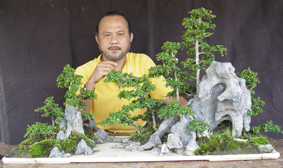While penjing and bonsai share many characteristics, they are different in many ways. And we often can find many casual and sloppy cross reference of penjing and bonsai (me too, guilty as charged. Since many people know the meaning of bonsai but not the meaning of penjing, sometimes I will refer a penjing to bonsai.)
Today, I came across Robert Steven’s blog and read his thoughts about penjing and bonsai. It is really thought provoking. Not only he talks about the basic foundational difference and similarities between penjing and bonsai like I did in Chinese Penjing and Japanese Bonsai, but Robert Steven also shares his thoughts on the style of an artist as well as the appreciation of artwork.
In my opinion, the term “authentic” has no relevance to art. An artist should be able to make his own statement of character and identity. I am not trying to create my own style, but rather trying to find new, innovative possibilities based on my own applications of aesthetic concepts. There is no absolute in art and beauty. For appreciation of artistic creation to occur there should be an emotional interaction between the art object and the viewer. This requires communication between the art object and the viewer.
And I really like how Robert Steven says it is the joyful process that matters, but not the final destination. This concept it quite different from what I have been taught. Not that I am taught not to enjoy the process, but it is the final “product” that counts the most. This gives me quite some pressure sometimes, especially when I mistakenly make the wrong cut (oopps… there goes 5 years!). By focusing too much on the technical aspect and getting too nervous about doing the “right” thing, sometimes I find myself missing the joyful process of being with my trees.
In making bonsai, I am not too concerned with the final destination, but rather with the joyful process. I enjoy the slow process of revealing the character and identity of the tree — a process that brings my life into parallel with the tree’s life journey. This sort of endeavor is more of an active meditative process and the cultivation of a soulful relationship with the artistic medium, instead of simply a superficial exploration of the medium. The communication between my medium and me may not take place with verbal communication, but there is an echo of understanding, nonetheless.
I wish Robert Steven will take a tour to Hong Kong and share with us his techniques and thoughts on bonsai someday.
I would also suggest you to read Robert Steven’s Introduction. Very interesting 🙂
Photo taken from The Bonsai Blog of Robert Steven.











